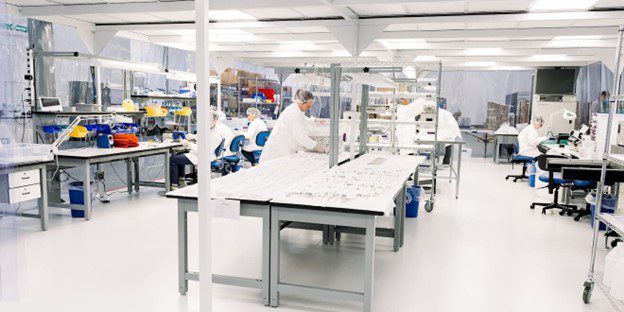FDA and EU GMP Standards_第4页
GMP, which stands for Good Manufacturing Practices, is a system that ensures that manufactured products—such as food, cosmetics, and pharmaceutical goods—are consistently produced and controlled according to set quality standards. Implementing GMP can help cut down on losses and waste, and avoid recalls, fines, and jail time. Overall, it protects both the company and the consumer from negative food safety events.
GMPs examine and cover every aspect of the manufacturing process to guard against any risks that can be catastrophic for products, such as cross-contamination, adulteration, and mislabeling.

|
| |
GMP A (ISO 5 )In theory, for a classified room (not just below a LAFW hood) to reach ISO class 5 air cleanliness, you need to enter the cleanroom via an ISO 8 (ante-room), then go through an ISO 7, followed by an ISO 6 to finally get into the ISO class 5 cleanroom. In reality, however, you can reach an ISO 5 cleanroom with 2 or 3 airlocks. The optimal layout depends on the process taking place inside the cleanroom, the size of the room, the number of people working inside, the equipment inside, etc. The filtered air sweeps down the room in a unidirectional way, at a velocity generally between 0.3 m/s and 0.5 m/s, and exits through the floor, removing the airborne contamination from the room. Cleanrooms using unidirectional air flow are more expensive than non-unidirectional ones, but can comply with more stringent classifications, such as ISO 5 or lower.
Some of our ISO 5 Cleanroom past projects : ISO 5 Nanofabrication cleanroom facility | GMP B (ISO 6 )In theory, for an entire room to reach ISO 6 air cleanliness, you need to enter the cleanroom via an ISO 8 (ante-room), then go through an ISO 7, to finally get into the ISO 6, as shown in the image. In reality however, you can reach an ISO 6 cleanroom with 1 (recommendation is 2) airlock. Again, it depends of the size of the room, the process taking place inside the cleanroom, the number of people working inside, the equipment inside, etc. Unidirectional air flow is sometimes recommended to reach ISO 6 classification. For a room of less than 4–6 meters in width (depending on the activities taking place inside the cleanroom), air returns can be positioned on the side of the walls instead of in the floor. Installing air returns in the floor is more expensive.
Some of our past ISO 6 cleanroom projects: Biopharmaceutical cleanrooms Animal laboratories ISO 6 cell production cleanrooms | |
|
| |
GMP C (ISO 7 )This is one of the most common classes of cleanrooms. If you need an ISO 7 cleanroom, you should consider having an ISO 8 airlock/gowning room prior to entering the ISO 7 room. The air changes per hour will vary in both rooms as described below.
Non-unidirectional air flow Some of our ISO 7 Cleanroom past projects : Clinical Manufacturing Facility for Cell and Gene Therapy – CGMP cleanroom ISO 7 cleanroom for Nutraceutical Industry Clinical Trials – Drug Development cleanroom ISO 7 sterile compounding non-hazardous facility In-Hospital compounding cleanroom – ISO 7 ( USP-797 ) | GMP D (ISO 8 )Let’s assume that an unclassified space (office or lab) is ISO 9. In this case, you can directly enter an ISO 8 cleanroom, without an airlock. Depending on the production process inside the cleanroom, however, you may have to add a gowning room.
Non-unidirectional air flow Some of our ISO 8 Cleanroom past projects : ISO 8 cleanroom for Pharmaceutical Manufacturing Cleanroom for Pharmaceutical Industry Cleanroom wall addition for Medtech Manufacturer ISO 8 cleanroom for Medical Device Manufacturing |
| ||||||||||||||||||||||||||||||||||||||||||||||||||||||||||||||||||||||||||||||||||||
| ||||||||||||||||
| ||||||||||||||||||||||||||||||||||||||||||||||||||||||||||||||||||||||||||||||||||||||||||||||||||
FAQ
What processes are regulated by GMP standards for food and drugs?
Quality management,Sanitation and hygiene,Building and facilities,Equipment,Raw materials,Personnel,Validation and qualification,Complaints,Documentation and recordkeeping,Inspections & quality audits.
What is the difference between GMP and cGMP?
Good Manufacturing Practices (GMP) and current Good Manufacturing Practices (cGMP) are, in most cases, interchangeable. GMP meaning the basic regulation promulgated by the US Food and Drug Administration (FDA) under the authority of the Federal Food, Drug, and Cosmetic Act to ensure that manufacturers are taking proactive steps to guarantee their products are safe and effective. cGMP, on the other hand, was implemented by the FDA to ensure continuous improvement in the approach of manufacturers to product quality. It implies a constant commitment to the highest available quality standards through the use of up-to-date systems and technologies.
What are the 5 Main Components of Good Manufacturing Practice?
2It is paramount to the manufacturing industry to regulate GMP in the workplace to ensure consistent quality and safety of products. The five main components of GMP, commonly referred to as the 5P’s, help organizations comply with strict standards throughout the entire production process.
What are the GMP Standards?
GMP standards are developed to enhance the safety of manufactured products, especially pharmaceutical goods, and to ensure consumers get the highest quality possible. Adherence to GMP standards not only positively impacts the reputation of manufacturing companies but also reduces batch recalls and negative reports from consumers. Below are 4 measures you can follow to uphold GMP standards
How to do GMP certification?
Validation is the documented act of demonstrating instruments, processes, and activities that are regularlyused or done. This is done to check if they function according to expectations. GMP can involve a number ofthings to be validated, but it's good to focus on the following processes:
Process validation
Cleaning and sanitation validation
Computer system validation
Analytical method validation
How to Comply with Guidelines?
GMP guidelines and regulations address different issues that can influence the safety and quality of a product. Meeting GMP or cGMP standards helps the organization comply with legislative orders, increase the quality of their products, improve customer satisfaction, increase sales, and earn a profitable return on investment.
 +86 18186671616
+86 18186671616 Jason@cleanroomequips.com
Jason@cleanroomequips.com
 MENU
MENU












